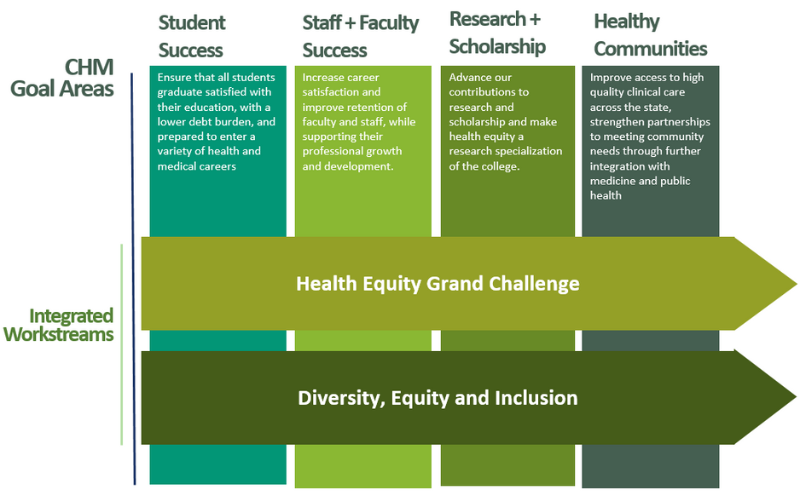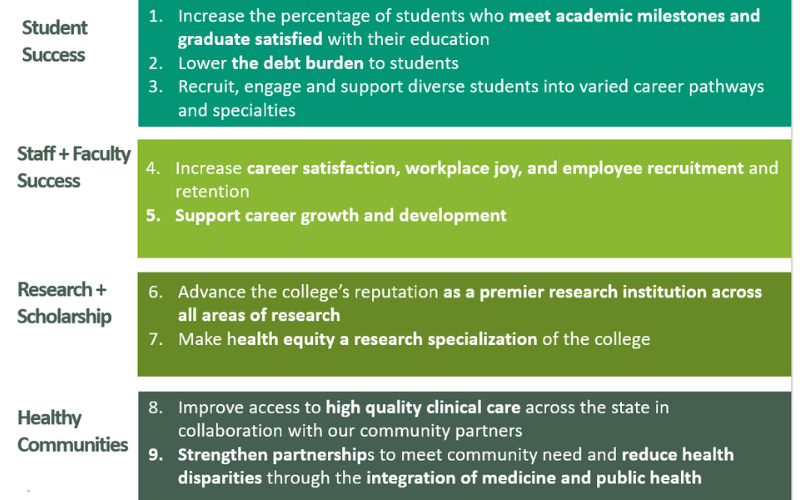Strategic Goals and Pillars

Based on findings and insights identified through the planning process, the College of Human Medicine’s strategic planning committee identified four goal areas:
- Student Success: Ensure that all students graduate satisfied with their education, with a lower debt burden, and prepared to enter a variety of health and medical careers.
- Staff and Faculty Success: Increase career satisfaction and improve retention of faculty and staff, while supporting their professional growth and development.
- Research and Scholarship: Advance our contributions to research and scholarship and make health equity a research specialization of the college.
- Healthy Communities: Improve access to high quality clinical care across the state and strengthen partnerships to meet community needs through further integration of medicine and public health.
Two intertwined workstreams focused on Health Equity and Diversity, Equity and Inclusion cut across each of the goal areas and have been embedded into goal area strategies.

Below we describe the nine strategic imperatives for the next seven years followed by the specific tactics we will use to pursue or explore them.

Ensure that all students graduate satisfied with their education, with a lower debt burden, and prepared to enter a variety of health and medical careers. Our work as a college is centered on the success and preparation of our students. All students deserve a positive educational experience that prepares them to become the health and medical professionals of the future. We are committed to providing our intentionally diverse student body with an array of support services that meet both academic and personal needs so that all college students graduate within anticipated timelines. In addition, we continue to explore ways to lower the overall cost of medical school attendance with tuition assistance and other funding supports.
Goal 1: Increase the percentage of students who meet academic milestones and graduate satisfied with their education
- Strategy 1: Enhance the proactivity of academic support.
The college is focused on smoothing the transition of students into the academic environment through the provision of personalized support to students. For example, some students benefit from a review of foundational material, while others may need additional academic assistance to meet key academic milestones. - Strategy 2: Expand student access to non-academic and personal support.
We are committed to helping students successfully navigate the variety of planning and support services available to them. Through a mix of peer, faculty, and Student Affairs/graduate program supports, the college is strengthening the safety net of services designed to help students thrive.
Goal 2: Lower the debt burden to students
- Strategy 1: Increase student scholarships and other funding opportunities.
The college is working with philanthropic partners to expand the availability of full and partial scholarships across different degree and certificate programs. In addition, we are committed to expanding programs that provide loan repayment and/or debt forgiveness options, including those based upon residency and workforce placements. - Strategy 2: Capitalize on the medical degree’s competency-based flexibility so students can complete the MD degree requirements in less than 4 years.
The college will further develop opportunities for students to accelerate degree completion. For example, some medical school students have met all requirements and demonstrated key competencies and, thus, may be able to forgo their last semester.
Goal 3: Recruit, engage and support diverse students into varied career pathways and specialties
- Strategy 1: Broaden student exposure to career exploration.
The college is committed to increasing student awareness of the array of career opportunities in health and medicine both in community and hospital settings, including but not limited to the health care industry, medical research, and health-related entrepreneurship. - Strategy 2: Strengthen mentorship for students from diverse backgrounds.
The college is committed to expanding and strengthening career mentoring for our diverse student population. This includes broadening our pool of mentors (faculty, staff, clinicians, partners, and alumni) and providing training on best practices in mentoring. - Strategy 3: Increase opportunities for students to engage in research and scholarship.
The college will create more opportunities for connection between students and research faculty early in students’ educational program, identifying space within curriculum for enhanced research opportunities and research-oriented mentorships. Efforts will also include expansion of dual degree opportunities for students (MD-MBA, MD-MPH, MD-PhD, etc.).
Strategy 4: Create an academic medicine pathway program for medical students and residents.
The college will develop a program for interested students to explore careers as academicians, thereby creating an internal pipeline for future faculty. We will nurture interest among students and residents by providing teaching and curricular opportunities as part of the college experience.
Strategy 5: Advance our reputation as a premier training ground for future clinicians and graduate degree trained professionals from diverse backgrounds.
The college will invest in necessary communications resources to ensure its message to future applicants, current students and alumni reflects our mission and priorities as well as highlights our graduates’ and students’ success in a variety of career pathways and specialties.
Increase career satisfaction and improve retention of faculty and staff, while supporting their professional growth and development. Our greatest asset is our people – faculty, support staff, and academic staff. We are committed to demonstrating the high value the College of Human Medicine places on all employees, recognizing and celebrating contributions, supporting work-life balance, and providing ongoing career and skill development. Our aim is to instill a sense of belonging and joy that translates into strong employee recruitment and retention.
Goal 4: Increase career satisfaction, workplace joy, and employee recruitment and retention
- Strategy 1: Assess and respond to data on career satisfaction and employee retention.
The college will collect baseline qualitative and quantitative data against which to measure progress – and areas for improvement – at periodic intervals. - Strategy 2: Establish policies and practices to improve workplace diversity.
Through targeted outreach and increased representation of applicants from underserved populations and communities, the college will strengthen its commitment to diversifying staff and faculty, measuring progress against Michigan State University Diversity metrics. - Strategy 3: Promote a culture of inclusion, transparency, and employee engagement.
The college will examine policies, structures, and practices in terms of their influence on employee connections to the college, representation in governance, and engagement in decision-making. Where needed, policies, structures, and practices will be changed and aligned with core principles of equity and inclusion. - Strategy 4: Revise compensation packages to improve equity and retention.
The college will partner with the university to conduct a review of the entire compensation package for faculty and staff, evaluating it in terms of its influence on employee recruitment and retention. As part of this effort, the college will seek changes in policies tied to staff classifications to achieve equitable compensation.
Strategy 5: Advance our reputation for hiring and nurturing talent.
The college will prioritize and publicize efforts that highlight the college’s support of career satisfaction, workplace joy and employee recruitment and retention.
Goal 5: Support employee career growth and professional development
- Strategy 1: Standardize policies tied to faculty performance and mentoring.
The college will utilize best practices to standardize structures and policies governing performance reviews, supervisor feedback, and faculty mentorship (including non-tenure track faculty) across departments and campus locations statewide. - Strategy 2: Develop a roadmap that outlines career and leadership development for faculty, staff, and academic staff.
The college will define expectations and opportunities for faculty, staff, and academic staff to demonstrate citizenship and leadership roles designed to reinforce employee engagement and retention. - Strategy 3: Expand access to professional development for faculty, staff, and academic staff.
The college will increase awareness of existing, internal professional development and educational assistance resources and encourage utilization of these resources. As part of the standardization of participation in professional development, every employee will craft a plan tied to individual career goals and trajectory. - Strategy 4: Promote and build capacity of faculty, support staff, and academic staff to conduct public intellectual work.
The college will involve all faculty as well as interested support staff and academic staff in training designed to raise the college’s profile and reputation in the larger community. This will include training in media, writing and speaking engagements, as well as web and social media visibility and outreach.
Advance our contributions to research and scholarship and make health equity a research specialization of the college. We are committed to raising the profile of the College of Human Medicine as a leader in academic research. Through investments in faculty and staff recruitment, research infrastructure, and enhanced communication strategies, we will expand and strengthen our capacity to generate and disseminate relevant and actionable research. Health equity will assume a larger place in our research agenda, supported by funding, policy changes and other structural support.
Goal 6: Advance the college’s reputation as a premier research institution across all areas
- Strategy 1: Significantly increase federal and other research funding.
Increased faculty recruitment coupled with systemic identification of grant and other funding opportunities will yield a larger research and clinical trial portfolio for the college. This emphasis on research will also include support of intradisciplinary teams and partnerships between basic scientists, clinical scientists, and community partners. The college will prioritize the pursuit of large NIH, NSF, SAMHSA grants and other major opportunities that involve teams of researchers. - Strategy 2: Expand research infrastructure within the college.
The college will invest in the capacity of the research office to support more active engagement of faculty, while also strengthening relationships with the MSU Office of Research and Innovation. In addition, the college will continue to strengthen infrastructure to conduct clinical trials and other laboratory research. - Strategy 3: Foster faculty interest in pursuing federally funded research.
The college will create a program to build the capacity and skills of non-research focused and junior research-focused faculty and clinicians in grant and proposal writing. Through mentorship and skills development opportunities, more interested faculty will be engaged in research projects. - Strategy 4: Publicize major research initiatives and accomplishments.
The college will raise the profile of its research endeavors through increased focus on externally oriented communication. Investments in staffing and infrastructure for the college’s Marketing and Communications Office will accompany this focus.
Goal 7: Make health equity a research specialization of the college.
- Strategy 1: Nurture the talent and interests of faculty and students in health equity.
Through the development of certificate programs, summer institutes, and other programs (e.g., Research to Reduce Disparities in Disease Program), the college will provide opportunities for faculty and students to learn about and become involved in research that addresses health equity. - Strategy 2: Encourage research that connects to health equity and social justice agenda.
The college will encourage research-focused faculty members to integrate an aspect of health equity into their research agenda. Each unit/department will identify at least one point person willing to collaborate on a health equity research program or project including community-based participatory research, implementation science, and/or clinical trials. - Strategy 3: Create collaborative networks/communities of researchers around health equity.
The college will establish a multi-disciplinary program for building awareness of health equity and advancing research that explicitly integrates health equity. This “hub” will leverage emergent opportunities and forums around MSU Sustainable Health goals to bring together multidisciplinary faculty and researchers from across the university. The college will provide funding and stipend for a position to facilitate emerging collaboratives and communities of practice focused on health equity. - Strategy 4: Recruit and retain research faculty focused on health equity (see also Staff and Faculty Success).
The college will institute pathways into tenure track positions for faculty (e.g., post-docs who are NIH Principal Investigators), prioritizing faculty with health equity research portfolios and interests who are also underrepresented in medicine.
Improve access to high quality clinical care across the state, strengthen partnerships to meeting community needs through further integration with medicine and public health. As a community based medical school, our faculty provide care throughout the state of Michigan. Yet demands on faculty time as well as significant market pressure and ongoing changes in the health care industry require us to focus our investments and consider how and where we can best serve the community. We will start by assessing our own capacity as well as the needs of the community. Our priority will be on attracting and retaining clinicians reflective of the communities they serve as part of our efforts to reduce community health disparities. We will further explore how we can leverage assets outside of the clinical setting, including our public health colleagues, to integrate and advance health equity. All the while we must invest in our community campuses and provide the infrastructure needed to provide the highest quality and most accessible care possible.
Goal 8: Improve access to high quality clinical care across the state in collaboration with our community partners.
- Strategy 1: Establish hybrid on-site and telehealth clinical models to expand community access (particularly in rural communities) with community partners.
The college will assess community needs and its own clinical capacity to create a viability plan for how best to serve the needs of communities across Michigan. The plan will seek to establish hybrid on-site and telehealth options to help expand access in rural and/or remote areas of the state and meet the needs of these community and hospital partners. - Strategy 2: Develop a recruitment and retention plan for clinicians and specialists in coordination with Office of Health Sciences, MSU Health Care, and other colleges at MSU.
On our own and with university partners, the college will systematically assess clinical capacity, prioritize recruitment, and enhance retention. The resulting plan will explore year 1 funding options for clinicians based on hiring priority as well as longer term sustainability planning. Data from college and university vacancy rates, exit interviews, community need, and market assessments will be used to help identify gaps and develop recommendations. - Strategy 3: Create standardized scaled best practices for all eight (8) campuses on how to partner and collaborate with community partners to improve access to care.
The college will identify needs and standardize infrastructure for students and faculty across the eight campuses. The college aims to develop financial support strategies that will establish a pool of funds that can be used to further invest in campus communities. In addition, the college will facilitate cross collaboration and communication among faculty and across campuses to improve outcomes in all missions. - Strategy 4: Collaborate with community partners to attract and retain clinicians who can improve health care access in underserved communities.
The college will develop pipeline programs and incentives to recruit and retain clinical faculty focused on reducing health disparities as well as those from underserved communities. The college will further consider creating a "health equity" pool to support recruitment and retention of faculty serving underserved, hard to reach communities as part of its grand challenge. - Strategy 5: Advance our reputation in providing high quality, community-based care.
The college will identify and improve challenges in practice plan environments, including administrative efficiencies, policies, electronic medical records (EMR) and scheduling with an eye toward increasing care and our reputation. The college will further evaluate establishing minimum effort percentages for clinical and academic responsibilities to support the clinical mission.
Goal 9: Strengthen partnerships to meet community need and reduce health disparities through the integration of medicine and public health
- Strategy 1: Continue pioneering community-partnered institution building including exploration of community stakeholder governance structures.
The college will explore establishing a community stakeholder governance structure for the college and its departments. It will also seek to build the capacity of community partnerships, developing deeper relationships with community providers serving underserved, uninsured communities across our campuses. - Strategy 2: Strengthen hospital partnerships across the state to match the educational needs of the college with the clinical needs of the hospital and the community they serve.
The college will assess and enhance data and information sharing between itself and its community hospitals. It will further develop performance dashboards based upon agreed upon data (e.g., number of students that return to a community of practice, MSU financial impact on the community) to help support and advance mutual needs. - Strategy 3: Enhance partnerships with government and philanthropy that enable the College of Human Medicine to serve low-income / uninsured community members.
The college will pursue and expand opportunities to work with government and philanthropic partners to better understand and meet community needs. This will involve relationship building with philanthropy and government agencies in each of our campus locations. In close communication with the college’s Advancement Office, we will advocate for government funding that will enable the college to serve more low-income and uninsured community members. - Strategy 4. Develop and strengthen partnerships within the college and across the university focused on health equity and sustainable health goals.
The college will support cross-departmental and cross-college collaborative efforts for program development and service enhancement. - Strategy 5: Engage in a broad effort to evaluate a name change to the College of Human Medicine and Public Health.
The college will undertake a broad and inclusive conversation to ensure that our name, mission, and other attributes are consistent with the focus, needs, and priorities of its people.

